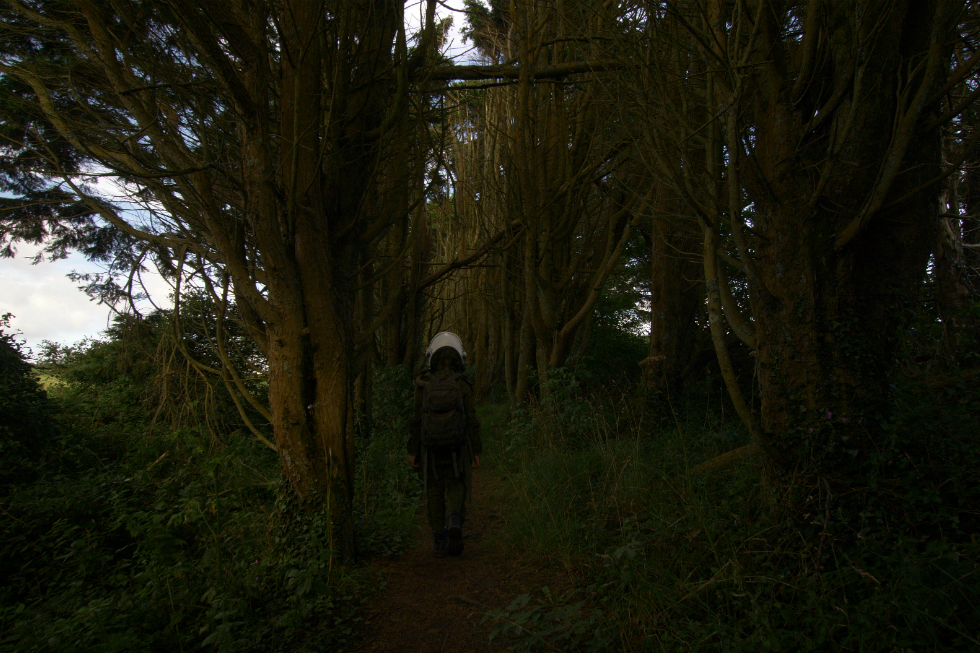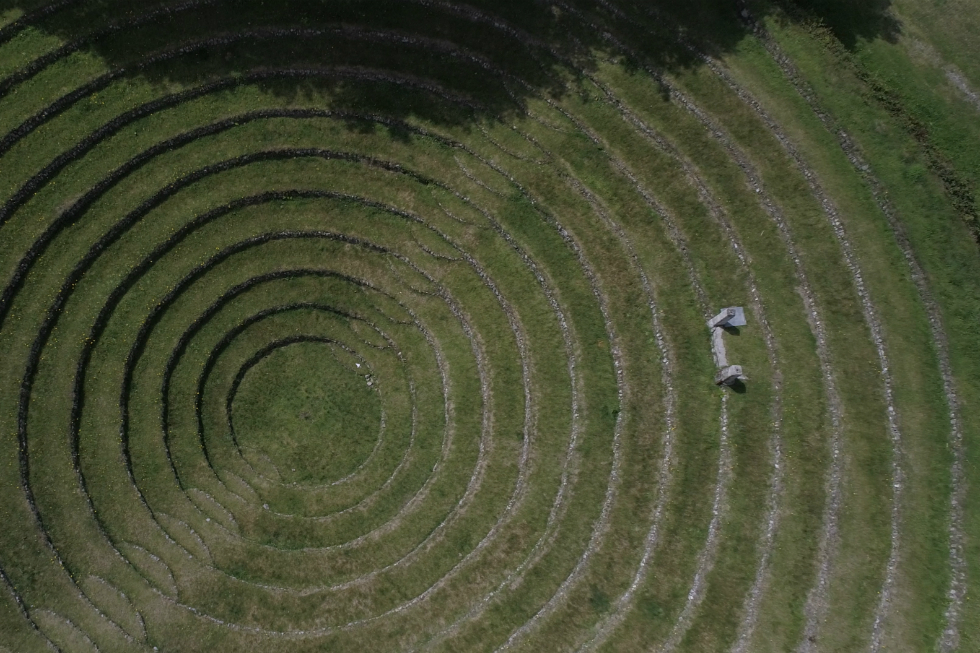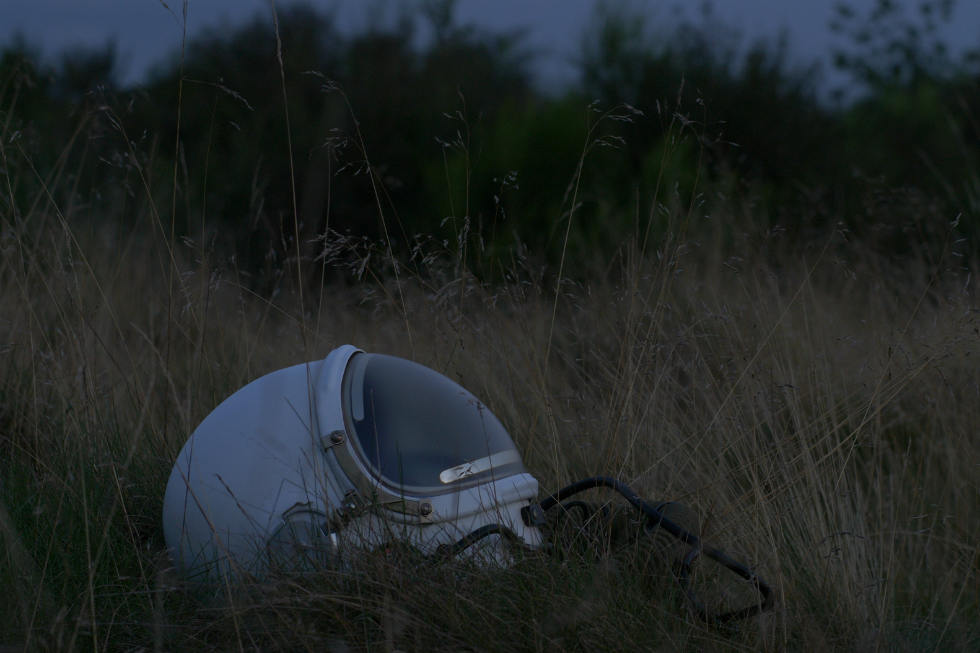“What I produced had to feel like it was a beacon of hope…” The Big Interview: Larry Achiampong
Mike Pinnington talks to artist Larry Achiampong about his residency at Tate Liverpool and some of the concepts and intellectual concerns – including science fiction, Pan Africanism, and a dire lack of representation in the arts – that are of crucial importance to his practice…
“For so long I have wanted to share these feelings of anguish with you. And I’m not sure I can even do that fully, even after all that has occurred. I hadn’t the tools to understand any of this myself. But now, I will try.” – Larry Achiampong, Relic Traveller 1
Based in London, the 34 year old, multi-disciplinary, British-Ghanaian artist Larry Achiampong’s work interrogates post-colonialism, class, cross-cultural and post-digital identities. He has had a fruitful, busy, year. His collaboration with fellow artist David Blandy saw The Finding Fanon trilogy (2015–17) screened at Tate Modern at the end of May ’17; in addition his solo work saw Achiampong establish himself more firmly. He exhibited at the Venice Biennale as part of the first Diaspora Pavilion, alongside British-based, ethnically diverse peers, including Barby Asante, Yinka Shonibare and Khadija Saye (who tragically died in the Grenfell Tower fire). Flying atop London’s Somerset House you can, until the end of the month, see Achiampong’s Pan African Flag for the Relic Travellers’ Alliance. Representing the 54 nations of the African continent, Achiampong has arranged the colours green (for land), black (to represent its people), red (its struggles) and yellow gold (symbolic of hope), while 54 stars represent its constituent, and united, countries.
A selection of Achimapong’s work, including film, projection, audio, props and research materials, can currently be seen at Tate Liverpool’s Tate Exchange space, part of a further exploration of the iterative Relic Traveller project; aiming to discuss and evolve ideas prevalent in his artistic practice. The display concludes this Sunday (21 Jan) with a performance titled Voyage of The Relic Traveller (with fellow artist Shiraz Bayjoo).
I spoke to Achiampong about Relic Traveller, among other things, and began by discussing how it is manifested at Tate Liverpool…
Achiampong on Relic Traveller
I want to use the [residency] time to be available to have conversations about the ideas in the work and to use it as reflection and plan ideas for Phase 2 of Relic Traveller. It’s a unique opportunity to focus on the work. For me, the ideas of building these ideas is a non-stop thing. How do these things culturally, scientifically, technologically link with this story of the Pan-African Union?
The way that we’re approaching the Tate Exchange situation, I became interested in the possibility of opening up aspects of the research and production of the work. It’s multifaceted… I’m looking to create an experience with projection, sound and performance.

On how he connects the Pan-African Union, pop culture and science fiction in his practice
Since a kid, sci-fi has been a big deal to me. I’ve watched all kinds of films and read all kinds of comics, and still do. I guess characters like Bishop from the X Men, Black Panther, Storm, Jubilee – a lot of comic characters of colour really appeal. I guess of all the stories, the Black Panther story appeals the most, simply because there’s this idea and conversation around the African continent, where there are particular minerals that allow the Wakanda nation to be the most technologically advanced. Not just on the planet, but the universe. There’s a great sense of responsibility that is dealing with that and the potential intrusion – not simply just from a Western perspective, but also aliens.
Black Panther takes aspects of real history, and asks a ‘what if’ question about a place untouched by the yoke of colonisation. With that in mind, my interest with the Pan-African Union was to consider these socio-political moments we’re living with, particularly the rise of nationalism within the West, and these ideas in the long run detract from progress. All culture, if it becomes isolated, over a certain period of time, it will suffer. Without labour, without certain means of materials and resources brought over by force or otherwise, the UK wouldn’t be what it is. Then you have this question of what if slavery never took place, you wouldn’t have the UK being as apparently great as it has been held over centuries. I was also thinking about the fact that the Pan-African Union are creating a new passport that would allow Africans and the diaspora to travel across the continent without problems. One part of the planet you have these boarders closing, another part of the planet you have these doors opening – what might that mean?
On ‘utopianism’
I’m asked why I have this utopian vision of the African continent. My response has always been: it’s not based within a utopia, it’s really based within considering aspects of responsibility with the way that certain people live. If people wipe themselves out as a result of ideas that push people away, rather than connect with them?
On his influences
Keith Piper’s work has been a big influence to me. His work, [plus] Lubaina Himid, the Smoking Dogs Team, John Akomfrah, Trevor Stuart.

On Liverpool’s links to the cotton trade and slave trade
Certainly one of the things that I wanted to do initially was to film in Liverpool. Unfortunately, the budget wasn’t able to cover that. But it’s certainly a big deal to me, [and] it will be nice to spend some time and dig deeper, research wise. In London, I’m currently doing a residency at Somerset House on the Embankment, which has a massive connection to so many institutions [including] the East India Company [which] has direct links to the slave trade. It’s definitely a point I want to investigate and have further conversations about with people who visit [Tate Liverpool].
On diversity, representation and oppression
When I think retrospectively about my art studies, there was always a lack of conversation around these issues, to the point I almost left my places of study; it wasn’t built for me. I want to see this reflected in visiting artists and lecturers and practitioners that come in. It’s a shame that it’s taken a while, but it is slowly happening. I hope it can happen more and openly in London. If we take Grenfell, the way that the government has made a great job of trying to cover that over – it’s despicable, disgusting, ridiculous. I find that to be a massive connection to these conversations. We’re talking about aspects of dehumanisation and continued oppression. That kind of activity is not really much different from a kind of gangster syndicate, where rent is taken and you’re not being looked after. It’s an approach where people’s bodies are not even numbers: they’re just things in the building. To the point where you can’t find how many people died or are still missing. That’s where I think these things need to be teased apart and laid out on the table for what they are.
On being a working class artist
I can be frank: class is such a big deal. Even on the basic level of resources; the working class person is going to have to do crazy amounts of work simply to survive, versus someone who has that privilege who can really just wait for an opportunity. People of privilege can use their connections. I don’t think that kind of conversation is opened up. As a result, you tend to have conversations with people who don’t think it’s anything really to do with class, it’s just how hard you work. Excuse me, but this is bullshit. It’s something I became aware of through study, [and] along the way in these 10 years of hustling. How you survive gets pushed to one side, but it matters in a massive way. What does it mean for artists who can’t hold down the multitudes of jobs? Just being able to see aspects of privilege that affords people time, comfort, care, safety, in comparison to those who are wondering how they will survive over the next month, or how can I make this money stretch for the project and pay the rent? The more I do this, I get straight to the point of discussing budgets because that aspect of fairness is a very important thing. I understand I’m getting a good opportunity, but I have to make sure this stretches. Naturally, those with privilege will be able to last longer as they have the resources to continue. It’s the haves and have nots.

On his commission, Pan African Flag for the Relic Travellers’ Alliance, at Somerset House
I was approached in March 2017 by Jonanthan Powell who curates Somerset House, [with] the potential opportunity of putting up a flag, as a result of increased public response to the likes of Jeremy Deller. After a couple of days, it sunk in that this was going to be one of my most public-facing works. It’s also an artwork you don’t have to go inside a space or an exclusive building to witness. There was a massive aspect of responsibility and an opportunity to create something powerful… To bring people together, to have conversations and really take something I’ve been trying to build over the years and open that up much more on a public level. It meant a great deal to me that obviously what I produced was going to be a good piece of work. Flags have a very colonial tinge to them – the Union Jack, the Star Spangled Banner. That was something I was wary of. What I produced had to feel like it was a beacon of hope. So yeah, that was a very special thing to work on, and the response has been great.
On access to art
I’m under the firm belief that not everybody’s going to go to a gallery, and that’s ok: let’s pick apart the reason why. It doesn’t mean that one shouldn’t strive to have the important conversations with people who feel excluded. I wanted the work to open up to as many people as possible, that people feel connected, [and] ownership is there.
Mike Pinnington
See a selection of the Relic Traveller project at Tate Liverpool’s Tate Exchange space, concluding this Sunday (21 Jan) with a performance titled Voyage of The Relic Traveller (with fellow artist Shiraz Bayjoo)
Image credits: video: Relic 1 (2017) Trailer from Larry Achiampong on Vimeo.
Detail, still of helmet in long grass: Relic 0 (2017), co-commissioned by Southbank Centre | Hayward Gallery & Jerwood Charitable Foundation. Courtesy of the artist
Detail, still of figure in woods and maze: Relic 1 (2017), commissioned by PS/Y. Courtesy of the artist





